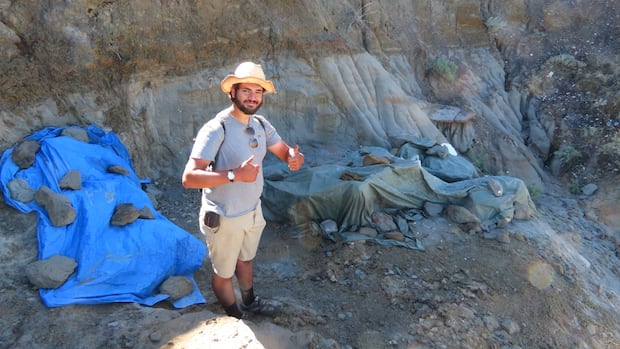Andre Mueller, a McGill University master’s student and former Medicine Hat resident, developed a passion for dinosaurs during his childhood. His recent discovery of a fossilized dragonfly wing in Alberta’s Dinosaur Provincial Park, located about 220 kilometers east of Calgary and 125 kilometers northwest of Medicine Hat, has unveiled a new species and marked the first such finding in Canada’s dinosaur-age rocks.
The breakthrough occurred in 2023 during a paleontology field course at the park led by Prof. Hans Larsson when Mueller, then an undergraduate student at McGill, stumbled upon the fossil. While the team’s primary focus was on locating plant fossils, Mueller’s keen eye spotted a peculiar rock the size of a toonie, which turned out to be a dragonfly wing. This unexpected find has shed light on a 30-million-year gap in the evolution of dragonflies.
Named Cordualadensa acorni, the new dragonfly species has significantly contributed to insect research in the region. The discovery has prompted further exploration, leading to the identification of additional insect specimens awaiting analysis. The dragonfly, comparable in size to a human hand, played a crucial role in the dinosaur ecosystem, albeit being a potential prey for raptors.
Published in the Canadian Journal of Earth Sciences on August 1, the study co-authored by Mueller, Alexandre Demers-Potvin, and Prof. Larsson introduced the new family Cordualadensidae based on the unique anatomy of the dragonfly. The name Cordualadensa signifies the densely packed chordalid wings of the species, while “acorni” pays tribute to John Acorn, a prominent lecturer at the University of Alberta renowned for promoting the province’s natural history.
Renowned paleontologist Philip Currie commended Mueller’s discovery for enhancing our understanding of the ancient environment and its inhabitants. The finding not only provides insights into the past but also paves the way for future insect-related research in the area. Larsson emphasized the significance of the fossil in bridging the previously unexplored gap in history, offering valuable information on dragonfly evolution and adaptation over time.
Mueller’s ongoing efforts at Dinosaur Provincial Park aim to unearth more hidden treasures, further enriching our knowledge of prehistoric life in the region.



